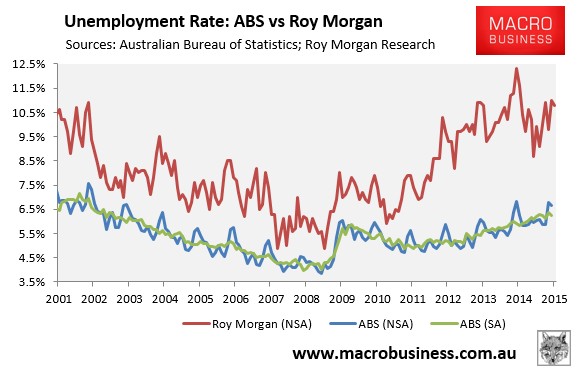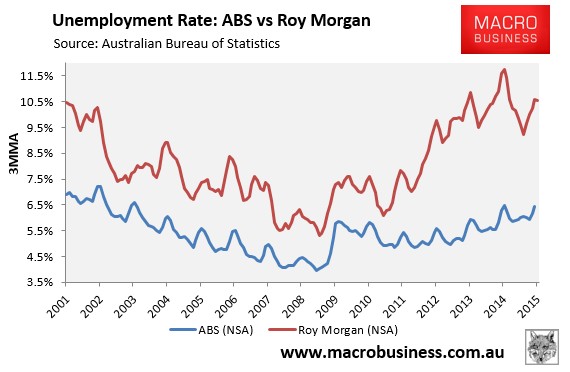Roy Morgan Research (RMR) has released its unemployment estimate for the month of March, which registered a 0.2% fall in the unemployment rate to 10.8% from 11.0% in February. However, unemployment was down 0.8% over the year (see next chart).

According to Gary Morgan:
Roy Morgan’s employment estimates contain some positive indicators with Australia’s total employment in March increasing over the past year to 11,302,000 (up 172,000). Driving the increase in employment was a strong increase in full-time employment to 7,586,000 (up 222,000) while part-time employment fell to 3,716,000 (down 50,000).
“The rise in employment over the past year has been echoed by a fall in unemployment to 1,368,000 (down 97,000) – although still far too high at 10.8% while under-employment increased to 976,000 (up 31,000) over the same period – now at 7.7%. This is a total of 2.34 million Australians (18.5%) who are either unemployed or under-employed.
“Although unemployment has fallen slightly from a year ago – it is still far higher than usual. The first few months of last year saw a pronounced spike in Australian unemployment. Unemployment in February 2014 reached 12.3% – a twenty year high. Today’s estimates mean total Australian unemployment and under-employment has now been above 2 million Australians for 40 straight months.
As explained each month, RMR measures employment differently from the ABS:
According to the ABS definition, a person who has worked for one hour or more for payment or someone who has worked without pay in a family business, is considered employed regardless of whether they consider themselves employed or not.
The ABS definition also details that if a respondent is not actively looking for work (ie: applying for work, answering job advertisements, being registered with Centre-link or tendering for work), they are not considered to be unemployed.
The Roy Morgan survey, in contrast, defines any respondent who is not employed full or part-time and who is looking for paid employment as being unemployed…
Since Roy Morgan uses a broader definition of unemployment than the ABS, it necessarily reports a higher unemployment figure. In addition, Roy Morgan’s measure tends to be far more volatile, owing to the fact that it draws on a smaller sample than the ABS and is not seasonally adjusted.
The difference between the ABS unemployment rate (6.7% NSA as at February) and the unofficial RMR measure is now 4.1% (see next chart).

The ABS will release its labour force statistics for March on Thursday 16 April.

